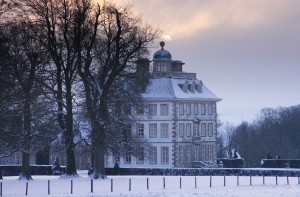Nicola Cornick's Blog, page 23
January 13, 2012
Nuneham Courtenay – A Regency example of Trip Advisor?
These days if we plan to visit a tourist attraction there are plenty of books and websites giving reviews of the place and all it has to offer. I had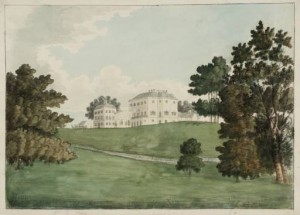 assumed that this was a relatively modern phenomenon until I read about the Nuneham Courtenay experience.
assumed that this was a relatively modern phenomenon until I read about the Nuneham Courtenay experience.
The mansion and flower garden at Nuneham Courtenay, eight miles south east of Oxford, was created by the 1st Earl Harcourt, (1714 – 1777) and his son the 2nd Earl Harcourt (1736 – 1809). There is some very interesting history about the building of the house here. The 2nd Earl was a friend of the French philosopher Rousseau and quite a political radical. He removed the coronets from his coaches and gave away the ancestral paintings. He also employed Capability Brown to enhance the landscape around his house. Between 1778 and 1781 the park was turned into an idealised landscape with a hanging wood, lush meadows and a country view. It was visible from the River Thames and one of the best ways to view the gardens was by boat. The Nuneham Park Fair, which the family established in the gardens during the 1770s was a very popular local event.
The 2nd Earl's revolutionary inclinations mellowed into a benign paternalism over the years and he decided to be more egalitarian by opening up his parkland and flower gardens to the public. Two thatched cottages beside a lock on the river at Nuneham Dingle provided refreshments for visitors, including cold meats, tarts, cake and fruit with port, sherry, champagne and bitter ale to drink.
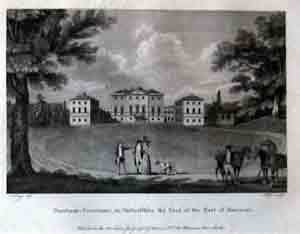 The gardens were open from May to September, much as many stately homes are now, and they proved a popular place to visit. A Visitors' Book from 1815 – 1825 records the impressions of a number of people. Unfortunately, just as in the present, not all reviewers were kind. There were quite a few students and academics who would make the trip out from Oxford, get "drunk as lords" at the refreshment cottage and then write rude comments or naughty rhymes in the book. One commenter calling himself "David Doggerel" wrote in 1817:
The gardens were open from May to September, much as many stately homes are now, and they proved a popular place to visit. A Visitors' Book from 1815 – 1825 records the impressions of a number of people. Unfortunately, just as in the present, not all reviewers were kind. There were quite a few students and academics who would make the trip out from Oxford, get "drunk as lords" at the refreshment cottage and then write rude comments or naughty rhymes in the book. One commenter calling himself "David Doggerel" wrote in 1817:
"Well does the dinner and the day agree, the dishes are all cold and so are we."
Lord and Lady Harcourt did not hold back in responding. Not for them the gracious reply or a discreet ignoring of critical remarks! Offending comments were either erased, torn out of the book, or the Harcourts would retaliate with sarcasm. On one occasion they wrote:
"All ladies and gentlemen who are ambitious to perpetuate their names by inserting them in the book should first learn how to spell them and if possible write legibly so that Lord and Lady Harcourt may at least have the felicity of knowing whom they accommodate."
There were of course more august visitors as well as the common crowd; In 1780 King George III visited Nuneham, as did the Archduke of Austria. In 1815 Warren Hastings, one time Governor General of India, visited. So did the Governor of Oxford Castle. These were treated as very special visitors, given a private tour and accommodated at the house. Lord Harcourt still had a respect for rank and consequence!
According to the Visitors' Book most tourists were fairly local and all arrived by boat from Abingdon and Oxford. As early as 1815, Nuneham was the focus of several "works outings." An Oxford company, Wyatt's, arranged a trip for their employees that year. In 1817 the employees of Speakman and Fisher, a tailoring company, came out on a day trip and in 1824 Coles' Coachmakers paid a call. In 1818 the Berkshire Yeomanry day trip ended in acrimony when the soldiers became very drunk. Other visitors disapprovingly referred to them in the book as "drunken dogs."
was the focus of several "works outings." An Oxford company, Wyatt's, arranged a trip for their employees that year. In 1817 the employees of Speakman and Fisher, a tailoring company, came out on a day trip and in 1824 Coles' Coachmakers paid a call. In 1818 the Berkshire Yeomanry day trip ended in acrimony when the soldiers became very drunk. Other visitors disapprovingly referred to them in the book as "drunken dogs."
Other entertainment on offer included rowing and fishing on the Thames and in hot summers men would apparently bathe naked in the river! Some visitors commented unfavourably on the gardeners and greenkeepers who, on one occasion, threatened to shoot the ladies for walking on the grass before it had been cut. All in all it sounds as though Nuneham was a very entertaining day out!
Later the landscape park featured in several of the Alice in Wonderland stories by Lewis Carroll.
©2012 Nicola Cornick. All Rights Reserved.
.January 11, 2012
Anne Gracie at UK Regency Authors!
Today it is my great pleasure to welcome Anne Gracie to the UK Regency Authors' blog. Anne is blogging about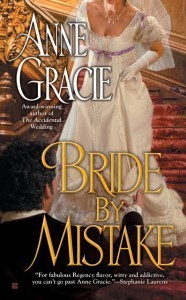 her wonderful new historical romance, Bride By Mistake, and the theme of heroes and their honour. Don't miss it!
her wonderful new historical romance, Bride By Mistake, and the theme of heroes and their honour. Don't miss it!
Meanwhile I am blogging at the Word Wenches about a few of my favourite things from the Edwardian era. I'd be thrilled if you dropped by!
©2012 Nicola Cornick. All Rights Reserved.
.January 9, 2012
Contest Winners!
Congratulations to all the contest winners and thank you to everyone who has entered the blog and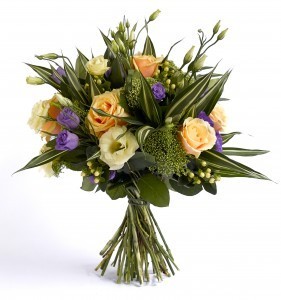 website contests. Carla won the set of Bluestocking Brides books and an Amazon gift voucher. Marianne, Shelley and Melanie won copies of Dauntsey Park in the contest here and at UK Regency authors. Thank you so much to everyone who took part!
website contests. Carla won the set of Bluestocking Brides books and an Amazon gift voucher. Marianne, Shelley and Melanie won copies of Dauntsey Park in the contest here and at UK Regency authors. Thank you so much to everyone who took part!
There is a new contest here on the website with a copy of Lord Greville's Captive and a cute book of Edwardian paper dolls to be won!
©2012 Nicola Cornick. All Rights Reserved.
.January 7, 2012
More from the Edwardian Era!
Today I am blogging about Edwardian fashion and food over on the UK Regency Authors blog! Plus there is a copy of Dauntsey Park to be won. Come and join me!
there is a copy of Dauntsey Park to be won. Come and join me!
©2012 Nicola Cornick. All Rights Reserved.
.January 6, 2012
Introducing Rochester
This is Rochester, our seven week old guide dog puppy. He arrived yesterday and is settling in nicely! He is a confident and clever little puppy who is quick to learn. During the coming year, Rochester will be taking his first steps towards becoming a fully qualified guide dog for the blind. Rochester has his own blog here where you can check up on his progress!
year, Rochester will be taking his first steps towards becoming a fully qualified guide dog for the blind. Rochester has his own blog here where you can check up on his progress!
©2012 Nicola Cornick. All Rights Reserved.
.January 3, 2012
Dauntsey Park: The Last Rake in London
This week sees the UK re-release from MIRA of my 2008 book The Last Rake in London with a new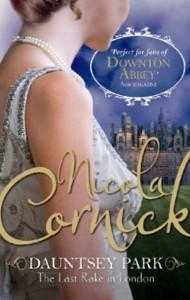 title, Dauntsey Park, and a beautiful new cover. Dauntsey Park is set in the Edwardian period and it was a book I wrote to celebrate the Mills & Boon Centenary. It is actually book 5 in the Bluestocking Brides series as it features the Kestrel family – but it is set 100 years after the other books in the series!
title, Dauntsey Park, and a beautiful new cover. Dauntsey Park is set in the Edwardian period and it was a book I wrote to celebrate the Mills & Boon Centenary. It is actually book 5 in the Bluestocking Brides series as it features the Kestrel family – but it is set 100 years after the other books in the series!
The Edwardian period has become very popular again as a result of the success of Downton Abbey. It's a fascinating period to write about; it has strong parallels with the Regency era but was also a time of huge social, political and economic change. The suffragette movement was claiming headlines with its demand for votes for women. The London underground was being built. Motor cars were first seen on the roads and the advent of the First World War hastened social change with more women taking jobs in order to help the war effort. The introduction of electricity into grand houses made a huge difference to lighting and to the way in which space was used.
The Edwardian style was particularly interesting, both above and below stairs. As in the Victorian era, the footmen were still chosen for their good looks and height and their livery was a mark of the status of the family they served. Housemaids had different uniforms for the morning and the afternoon. Ladies would change their clothes up to five times a day and even aristocratic men had a vast wardrobe of formal and informal clothing and, of course, sporting attire. Fashion was celebrated and fabrics were extremely rich and opulent. Underneath the gown was a lady's corset, which was designed to draw attention to the bosom, make the waist as small as possible and then push out at the rear. Add in lots of petticoats and it is no wonder that movement was restricted. A new design of corset came in during the period and this was more flexible but still trussed up a woman in laces and hooks.
Many married and titled ladies would take breakfast in bed and follow this with a long and luxurious bath and indulgence in various beauty treatments (always with products from the London shops of course!) Once the underwear had been fastened into place the long process of choosing a suitable gown would begin. The lady's maid had an important role in helping her mistress choose the appropriate gown for any occasion. Jewellery was seldom worn in the mornings other than plain silver or gold and rings. Interestingly this is a "fashion rule" that I learned from my grandmother who was born in the Edwardian period.
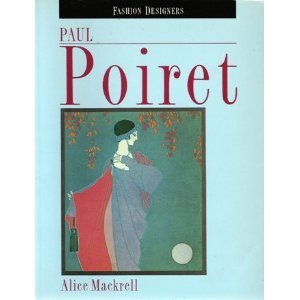 In Dauntsey Park I have my heroine Sally wear designs by Paul Poiret, a French fashion designer whose clothes were considered very cutting edge in the pre-First World War period. Sally is the daughter of a gentleman but because she was left no money and works for a living she is considered "fast." She is even more scandalous because she runs a night club and she was separated from her husband when he died. When she goes to Dauntsey Park she expects Lady Ottoline, the matriarch of the Kestrel family, very much to disapprove of her.
In Dauntsey Park I have my heroine Sally wear designs by Paul Poiret, a French fashion designer whose clothes were considered very cutting edge in the pre-First World War period. Sally is the daughter of a gentleman but because she was left no money and works for a living she is considered "fast." She is even more scandalous because she runs a night club and she was separated from her husband when he died. When she goes to Dauntsey Park she expects Lady Ottoline, the matriarch of the Kestrel family, very much to disapprove of her.
Jack Kestrel, in contrast, is descended from the ancestral line of the Dukes of Kestrel with an aristocratic lineage going back hundreds of years. But society is changing in the Edwardian period; it is no longer unheard of for the middle classes or even foreigners to marry into the English nobility (there were many American heiresses who entered society at the time) and the First World War also increased social mobility. Jack himself is progressive in his views and is involved in the fledgling aviation industry.
If you would like to read more about the late Victorian/early Edwardian period I have posts on the Ashdown House blog on the role of the servants at Ashdown – here – and on Cornelia Martin, the American heiress who married into the Craven family – here.
To celebrate the launch of Dauntsey Park: the Last Rake in London, I am offering a copy of the book to two commenters on the blog! Just let me know whether you like books set in the Edwardian era.
For the chance to WIN the first three books in the Bluestocking Brides series go to my website contest – there's also an Amazon voucher on offer because you can never have too many books! Both contests end on Friday 6th and I'll announce the winners here on the blog!
©2012 Nicola Cornick. All Rights Reserved.
.December 31, 2011
Happy New Year!
This is the Waterloo Tower at Quex Park in Kent. It is a bell tower, built in 1819 for John Powell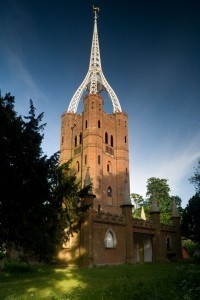 Powell, an eccentric whose interests included bell ringing, yachting and collecting cannon. The spire on the top was considered a very daring design for the date and looks a bit like the Eiffel Tower, which was not built until 1889.
Powell, an eccentric whose interests included bell ringing, yachting and collecting cannon. The spire on the top was considered a very daring design for the date and looks a bit like the Eiffel Tower, which was not built until 1889.
At midnight on New Years Eve the twelve bells ring out to welcome the New Year.
Ring out, wild bells, to the wild sky,
The flying cloud, the frosty light;
The year is dying in the night;
Ring out, wild bells, and let him die.
Ring out the old, ring in the new,
Ring, happy bells, across the snow:
The year is going, let him go;
Ring out the false, ring in the true.
Alfred Lord Tennyson.
Wishing you a very Happy New Year!
©2011 Nicola Cornick. All Rights Reserved.
.December 23, 2011
Season's Greetings and Happy Holidays!
December 21, 2011
Happy Winter Solstice!
Today is the shortest day of the year here in the Northern Hemisphere. A very Happy Winter Solstice (or Summer Solstice to those Down Under!)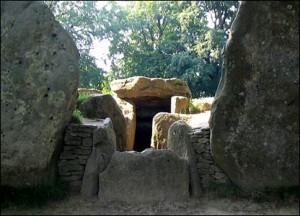
At dawn on the Winter Solstice the sun rises directly in line with the standing stones at Waylands Smithy, a Neolithic burial chamber on the hills high above my village. It's an awesome sight, especially on a cold frosty morning.
One of the legends associated with the Smithy is that if you leave your horse and a penny there overnight you will find the horse shod in the morning and the money gone. On two occasions when I have been walking through the woods there I have heard the sound of hoofbeats echoing on the track but seen no horses!
©2011 Nicola Cornick. All Rights Reserved.
.December 15, 2011
Three Wise Men… And a Dog!
2011 has been something of a challenging year for me, as it has been for many people I know. On the positive side I have had two books out in my Scandalous Women of the Ton series,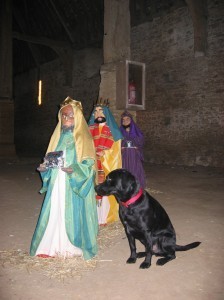 Notorious and Desired, and am just finishing the final book in the series, Forbidden. One Wicked Sin garnered a RITA nomination and Whisper of Scandal won the National Readers' Choice Award. I have been bowled over by the lovely reviews my books have gained and the lovely comments from readers. On a personal note I was able to take some wonderful trips around the UK and have enjoyed some very happy times with friends and family near and far.
Notorious and Desired, and am just finishing the final book in the series, Forbidden. One Wicked Sin garnered a RITA nomination and Whisper of Scandal won the National Readers' Choice Award. I have been bowled over by the lovely reviews my books have gained and the lovely comments from readers. On a personal note I was able to take some wonderful trips around the UK and have enjoyed some very happy times with friends and family near and far.
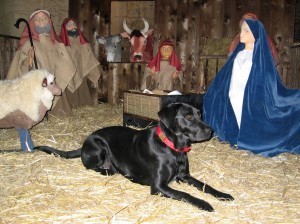 A very sad thing that happened this year was the loss of our beloved pet dog Monty at the age of just ten years. Monty was almost universally loved by all those who knew him. Even non-dog people were won over by his sunny Labrador nature. His only failure was to convince our cat, Bob, that dogs are a Good Thing. Monty was a particular fan of Christmas (all those interesting parcels under the tree!) and so in tribute to him and to the season, here are a couple of photos we took a few years ago when we took Monty to see the nativity crib in our local tithe barn. He wanted to join in and since I am sure all manner of animals would have been welcome in the original stable in Bethlehem, we thought this was rather nice. So this is for Bellbridge Montagu, to give him his "proper" name, the best animal companion a writer could ever have. Wishing you and all your family and friends, furry and other, a very Happy Christmas.
A very sad thing that happened this year was the loss of our beloved pet dog Monty at the age of just ten years. Monty was almost universally loved by all those who knew him. Even non-dog people were won over by his sunny Labrador nature. His only failure was to convince our cat, Bob, that dogs are a Good Thing. Monty was a particular fan of Christmas (all those interesting parcels under the tree!) and so in tribute to him and to the season, here are a couple of photos we took a few years ago when we took Monty to see the nativity crib in our local tithe barn. He wanted to join in and since I am sure all manner of animals would have been welcome in the original stable in Bethlehem, we thought this was rather nice. So this is for Bellbridge Montagu, to give him his "proper" name, the best animal companion a writer could ever have. Wishing you and all your family and friends, furry and other, a very Happy Christmas.
©2011 Nicola Cornick. All Rights Reserved.
.
